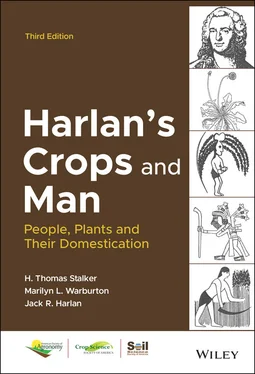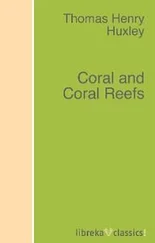There seems to be little doubt that the life cycles of plants were well understood by native Australians. The Aborigines were equipped with all the knowledge necessary to practice agriculture, but did not do so.
Klimek (1935) recorded 11 tribes of California peoples that grew a local species of tobacco, but no other crop. Some tribes in Oregon, Washington, and British Columbia followed the same practice (Drucker, 1963). The tobacco was usually either N. attenuata or N. quadrivalvis Pursh. Harrington (1932) made a very detailed study of tobacco among the Karuk, and found the extent of botanical knowledge remarkable. The Karuk burned logs in the forest and sowed seeds in the ashes. A tobacco garden was called “to plant” or more literally “to put seed.” The Karuk had terms for cultivated tobacco, wild tobacco, roots, stems, bark, leaves, branches, leaf branches, pith, gum, flowers, buds, seedpods, flower stem, clusters of flowers, sepals, and calyx. No standard word was used for petal, but descriptive terms were used, for example, the white‐flowered N. quadrivalvis was said to have “five white ones sticking out.” The stamens and pistil were described as “sticking out in the middle of every flower where the seeds are going to be.” Stamens are “flower whiskers,” “flower threads,” or “flower hairs.” Pollen is “flower dust.” Nine stages of flowering to seed setting were recognized with descriptive terms. There was a classification of seeds, grains, seeds in the midst of a fruit (pit), seeds inside a shell (nut), and so on.
The translation of an informant's description of germinating tobacco seed is botanically accurate and detailed (Harrington, 1932, p. 61):
Its seeds fall to the ground. The dirt gets over them. Then, after a while, when it gets rained on, the seed sprouts. Sometimes all the seeds do not grow up. They say sometimes some of the seeds get rotten. Its sprouts are small white ones, pretty near the size of a hair. Whenever it is just peeping out, its seed is on top of it. Then they just have two leaves, when they first peep out of the ground. They grow quickly when they grow; in a little while they are tall ones.
The Karuk fertilized with ashes, sowed, weeded, harvested, selected for strength, cured, stored, and sold tobacco, but grew no other crop. Clearly, the concept of planting seeds was in no way revolutionary and did not lead to food production (Harrington, 1932). Where did people ever get the idea that hunter‐gatherers did not know about life cycles of plants? The egocentricity of agriculturalists is extraordinary. The situation is summed up succinctly by Flannery (1968): “We know of no human group on earth so primitive that they are ignorant of the connection between plants and the seeds from which they grow… .”
General Botanical Knowledge
We should not be surprised if gathering peoples know a lot about plants. They are the real “professional botanists”; for them, life depends on an adequate knowledge of plants. We have seen that gatherers are familiar with hundreds of species and their uses for food. We have noted that many are poisonous and must be detoxified before they can be eaten.
Since “ignorance” is part of the stereotype developed by agricultural people about gatherers, I would like to call attention to an episode described with some apparent pleasure by Sir George Grey (1841). Some of the crew of Captain Cook's expedition of the 1770s observed the Aborigines eating seeds of Zamia (a cycad). The crew tried some of their own harvest of Zamia and became very ill. They concluded that the Aborigines must have very strong constitutions to be able to live on such food. Later, on shipboard, they fed Zamia seeds to some pigs, and a few died. Their admiration for the physical stamina of the natives increased substantially. The Aborigines, of course, had removed the poison before eating their seeds, and were, no doubt, amused at the “ignorance” of their European visitors.
Detoxification is required for a considerable number of plants used by the native people of North American, the Australian Aborigines, and gatherers in tropical zones. Some plants are deadly poisonous without treatment, others only unpleasant. Several acorn species are sweet and need no treatment, while others contain various amounts of tannins. Among California Native Americans, some of the bitterest oaks were the most popular; when properly leached, the original tannin content did not cause any harm. Tribes on the edge of the “acorn belt” were often more selective since they did not depend much on acorns and did not want to go to the trouble of leaching. Leguminous seeds, Solanaceous fruits, Dioscorea spp., and Aroid tubers are still among the more common poisonous foods consumed by gatherers.
Detoxification is usually by heat, leaching, or both. The plant material is frequently reduced by grinding or pounding in a mortar to facilitate treatment. Boiling water may be poured through the meal, the material may be boiled in several changes of water, or sometimes prolonged soaking in cold water is enough. Some foods are roasted, pounded, and then leached. Sieves, strainers, cloth sacks, wooden troughs, or sandbeds may be produced for the purpose. Pottery is not necessary; water may be boiled in baskets, hides, wooden boxes, or pits in the ground by dropping fire‐heated rocks into the water.
Gatherers not only know how to make poisonous foods safe, but they also know a great deal about drugs, narcotics, medicines, fish poisons, arrow poisons, gums, resins, glues, dyes and paints, bark cloth, and woods for spears, arrows, bows, shields, fire sticks, and canoes. They have also used their botanical knowledge in spinning and weaving, basket‐making, and constructing household utensils, fish traps and weirs, masks, figurines, and ceremonial objects.
The Australian Aborigine was fond of chewing a wild tobacco (mostly Nicotiana suaveolens Lehm.). Wood of Acacia salicina Lindl. was burned to provide ash to mix with the quid. Why this particular species out of dozens of Acacia? Johnston and Cleland (1933) analyzed the ash and found it extraordinarily high in calcium sulfate, “sulfuric anhydride 30.09% and lime 40.70%.” The alkaloids are more soluble in alkaline solutions. Perhaps any source of lime would do, but the practice reminds one of the custom in India of burning heartwood of Senegalia catechu (L. f.) P. J. H. Hunter and Mebb (syn: Acacia catechu (L.f.) Wild, Oliv.) to obtain “cutch” which is mixed with other ingredients and used when betel nuts are chewed.
Another masticatory of the Aborigines was Duboisia hopwoodii (F. Muell) F. Muell. This is of a different order of drug potency and contains hyoscyamine and norhyoscyamine, with scopolamine in the younger leaves (Johnston & Cleland, 1933). Both narcotics were confounded under the general name “pituri” and were important articles of trade over great distances; “shields, boomerangs, spears and other articles being sent in return for them.”
In the late 19th century, Father Trilles, a French missionary to Gabon, West Africa, observed pygmies making arrow poison. The process was long, complex, and dangerous, for the poisons were extremely potent. Ingredients of 10 different plants were used; eight were poisonous and two were gums to be impregnated with poison and stuck to the arrow heads. Two animal poisons were also included: beetle larvae and venom of a horned viper. The procedure is described in The Hunting Peoples by Coon (1971) who added this comment:
A tourist driving along a forest‐lined road, seeing an elderly, diminutive black man clad in a bark‐cloth breechclout, would have no reason to suspect that this child of nature knew the properties of many medicinal plants, some still undescribed in Western science, and how to combine them for their greatest effect. With the forest and marsh his pharmacy, his laboratory a secret nook in the shade of tall trees, and a minimum of equipment, the Pygmy poison‐maker performs a delicate, dangerous, and highly skilled sequence of operations as exacting as some modern professions.
Читать дальше












